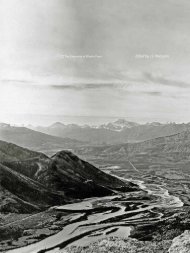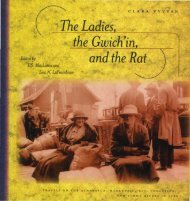Paul Kane's Journal of his Western Travels, 1846-1848 - History and ...
Paul Kane's Journal of his Western Travels, 1846-1848 - History and ...
Paul Kane's Journal of his Western Travels, 1846-1848 - History and ...
Create successful ePaper yourself
Turn your PDF publications into a flip-book with our unique Google optimized e-Paper software.
Dam has transfonned t<strong>his</strong> stretch <strong>of</strong> the river.<br />
Gr<strong>and</strong> raped [Athabasca River]<br />
See rapped de More.<br />
Gr<strong>and</strong> raped [Winnipeg River] Only a three-foot drop, t<strong>his</strong><br />
rapid on the Winnipeg River possessed the attraction that it<br />
could be run down or lined up, rather than portaged. It lay<br />
between Barrier Falls <strong>and</strong> Blanche River (see River NaIoin).<br />
gr<strong>and</strong> Rapid/gr<strong>and</strong> raped [Saskarchew,an River] T<strong>his</strong>, was a<br />
famous gr<strong>and</strong> rapids among many with the saIne name on the<br />
fur trade routes. Hooded by a bead pond today. it was three<strong>and</strong>-a-half<br />
miles long, <strong>and</strong> brought Cedar Lake <strong>and</strong> the waters<br />
<strong>of</strong> the Saskatchewan River tumbling into the northwestern<br />
comer <strong>of</strong> Lake Winnipeg. Kane passed it on August 18. <strong>1846</strong>,<br />
<strong>and</strong> June 17. <strong>1848</strong>. There is a town, Gr<strong>and</strong> Rapids, Manitoba.<br />
gr<strong>and</strong> rapped [Columbia River] Seven miles below Kettle Falls<br />
on the Columbia River. t<strong>his</strong> rapid was nonnally run, although<br />
<strong>Kane's</strong> brigade stove a canoe in it on November 24, <strong>1846</strong>~ as a<br />
consequence, Kane. who had elected to walk around it in order<br />
to sketch it, witnessed a resourceful rescue <strong>of</strong> its passengers,<br />
including Mr. <strong>and</strong> Mrs. Lane, by one <strong>of</strong> the boats that had<br />
already descended it successfully. In <strong>Kane's</strong> day, t<strong>his</strong> was<br />
marked on maps as lbompson Rapids, in honor <strong>of</strong> David<br />
Thompson, me North West. Company explorer who descended<br />
the Columbia River in 1811. It is now known as Rickey<br />
Rapids.<br />
gr<strong>and</strong> rapped [<strong>of</strong> September 12, <strong>1848</strong>]<br />
[or] faJ.h.<br />
gr<strong>and</strong> Shute See Isl<strong>and</strong> rapicb on [or] falls.<br />
See IsIaud rapich on<br />
Gr<strong>and</strong> Travers/Gr<strong>and</strong> Travrs Gr<strong>and</strong> Traver.ie marked the<br />
place where, coming out <strong>of</strong> the Athabasca Pass trail , eastbound<br />
brigades had to ford the Athab~ River. WA drama.ti:zes the<br />
ttaverse made by <strong>Kane's</strong> brigade on November 5, 1847: .• . ..<br />
my pack, oontaining sketches <strong>and</strong> curiosities, &c., had to be<br />
carried on the shouiders <strong>of</strong> the men ricling across. to keep them<br />
out <strong>of</strong> the water" (240).<br />
grond coat or big bill/ Gr<strong>and</strong> Coat Gr<strong>and</strong> COte was the fur<br />
trade name for the steep western slope <strong>of</strong> the Athabasca Pass,<br />
which followed Pacific Creek down to Wood <strong>and</strong> Canoe rivers<br />
before reaching Boat Encampment. More like climbing than<br />
hiking at some points, Gr<strong>and</strong> COte brought brigades in one<br />
day's travel from the height <strong>of</strong> the pass down to an elevation<br />
equal to that <strong>of</strong> Jasper House on the eastern slope.<br />
grose paint, Le See Le grose point.<br />
GrovantsGros Ventre (llidasta) occupiedpmiries mainly below<br />
the 49th parallel. During the nomadic period, they were members<br />
<strong>of</strong> the Blackfoot Confederacy, although not <strong>of</strong> the more<br />
limited Blackfoot Nation. Their linguistic affiliation is Dakotan<br />
(Siouan); their <strong>his</strong>tory is that <strong>of</strong> bison hunters; <strong>and</strong> their<br />
ttaditionalenemies were Cree <strong>and</strong>. Saulreaux.<br />
H., Mr. See HarlttlHarett/H., Mr.<br />
HaUet/lDIet, Mr. William Hallet (1810-1870) was a noted<br />
bison hunter <strong>and</strong> trader in the Red River Setd.ement. He was<br />
the son <strong>of</strong> Henry Hallet (1772?-1844), an Englishman who<br />
served in the fur trade until 1822. As late as 1861. theNor'Wes-<br />
74<br />
ler noted that dle faU bison hunt from the settlement had been<br />
Jed by William Hallet. Probably, Hallet's role in the spring hunt<br />
was less imJX)rtant. so that he had leisure to take Kane under <strong>his</strong><br />
wing, acquainting him not only with procedures for bison<br />
hunting but also with Metis culrural practices. While <strong>Kane's</strong><br />
journal suggests that, on June 26, <strong>1846</strong>, Hallet had gained<br />
Kane a head start for that day's hunt, WA elevates <strong>Kane's</strong><br />
purpose: ,. A half-breed, <strong>of</strong> the name <strong>of</strong> Hallett, who was<br />
exceedinglyanentive to me, woke me in the morning, to<br />
accompany him in advance <strong>of</strong> the party, that I might have the<br />
opportunity <strong>of</strong> examining the buffalo whllst feeding, before the<br />
conunencement <strong>of</strong> the hunt" (57).<br />
An "English" Metis, Hallet opposed Louis Riel's leadership<br />
<strong>of</strong> the Red River Metis; when the first &ed River Rebellion<br />
broJ(e out in the winter <strong>of</strong> 1869 - 1870, Riel had Hallet chained<br />
in an unheated room. Hallet was eventually released, but <strong>his</strong><br />
health was broken <strong>and</strong> he died a shoo time later. It is speculated<br />
that he ended <strong>his</strong> life by committing suicide.<br />
Haritt/Harett/H., Mr. John Edward Harriott (1797-1866)<br />
joined the North West Company in 1813 at age twelve. He<br />
served at Fort Carlton. before <strong>and</strong> after the merger with the<br />
HBC in 1821 ~ <strong>and</strong> then at Fort Assiniboine, Stuart Lake (in the<br />
northern interior <strong>of</strong> modern British Columbia), Piegan Post (a<br />
short-lived post [1832-1834] on the Bow River near modem<br />
Banff. Alberta), Rocky Mountain House (see (be Mountain<br />
Hoos), <strong>and</strong> Fort Edmonton. He was appointed to Chief Factor<br />
in <strong>1846</strong>, <strong>and</strong> was in charge <strong>of</strong> Fort Edmonton briefly when<br />
Kane wintered there in 1847 - <strong>1848</strong>.<br />
In <strong>his</strong> "Character Book, "Governor Simpson judged him<br />
"mild tempered, well disposed, <strong>and</strong> bears an excellent private<br />
character .... A finished Trader. Speaks Cree like a native <strong>and</strong><br />
is a great favourite with Indians: has much intftuence likewise<br />
with the people <strong>and</strong> is generally esteemed by <strong>his</strong> coUeagues"<br />
(197). When he retired to the Red River Settlement in t855, <strong>his</strong><br />
library was estimated at some 200 books. A correspondent to<br />
Harper's magazine wrote in the February, 1861 . issue <strong>of</strong> how<br />
Harriott's "life <strong>of</strong> exPosure <strong>and</strong>advenrure <strong>and</strong> toil is rounded<br />
with rest <strong>and</strong> calm <strong>and</strong> domestic peace. "<br />
Harriott married three times. His first wife, Elizabeth, suffered<br />
bouts <strong>of</strong> madness, the last <strong>of</strong> which sauck her in 1832 as<br />
she was crossing Athabasca Pass. She w<strong>and</strong>ered from the trail,<br />
never to be seen again; likely she is the "Gentabnans wife"<br />
referred to by Kane on November 2, 1847. She did not have<br />
her newborn baby (see Prudence, Mr.) with her when she<br />
disappeared. <strong>and</strong> the child managed to survive the trip to Fort<br />
Edmonton.<br />
Hunter, M/Mr. James Hunter (1817-1882) was ordained a<br />
priest <strong>of</strong> the Churcb <strong>of</strong> Engl<strong>and</strong> in 1844, the same year that he<br />
sailed with <strong>his</strong> wife to Hudson Bay <strong>and</strong> traveled to Cumberl<strong>and</strong><br />
Station, the new Indian mission where Kane encountered him.<br />
By <strong>1846</strong>, Hunter was raising cattle, horses, pigs (one <strong>of</strong> which<br />
was roasted in honor <strong>of</strong> <strong>Kane's</strong> visit in <strong>1846</strong>), <strong>and</strong> sheep, as<br />
well as crops <strong>of</strong> wheat, barley, <strong>and</strong> potatoes on the mission<br />
fann. By the time <strong>of</strong> <strong>Kane's</strong> rerum visit in June, <strong>1848</strong>, he had a<br />
church built from h<strong>and</strong>sawn local timber. Hunter provided dle<br />
first translations (using Roman characters) into Cree <strong>of</strong> the<br />
Gospels <strong>and</strong> Book <strong>of</strong> Common Prayer. He perfonned many<br />
baptisms annually, including some as far afield as Fort Simpson,<br />
on the upper Mackenzie River.<br />
Islaad npids on [or] faDs T<strong>his</strong> is Kettle Fans, between Namakan<br />
Lake <strong>and</strong> Rainy Lake in modem northwestern Ontario.<br />
Guide
















